Content
Sugar beet varieties and hybrids differ in many ways. But among them there are absolute leaders, bred as a result of many years of selection. Now you will learn about nine of the best beet varieties based on a combination of traits.
First of all, table beets should be tasty, safe for health and have a long shelf life. Many gardeners believe that the whole set of these qualities can only be found in varieties of foreign selection. Indeed - imported root crops are smooth and beautiful, consistently pleasing with a high yield. But even among the domestic varieties, you can find sweet and spicy varieties. We will tell you about the best of the best representatives of the beetroot world.
Bordeaux 237
This variety was bred by Soviet breeders in 1943. This is one of the most popular and studied mid-season varieties. The plant is thermophilic and demanding on lighting, but at the same time it is distinguished by drought resistance. Root crops are round and flat-rounded, with delicate flesh of a thick burgundy color. The sugar content is high, while the beets are stored for a long time without losing their taste. The variety is resistant to diseases, occasionally affected by cercosporosis and peronosporosis.
| Appointment | Root diameter (cm) | Beet weight (g) | The period from germination to technical ripeness (days) |
Yield (kg / sq.m) |
|
|
12-15 |
260-500 |
60-110 |
4-8 |
||
Bravo
One of the most productive, unpretentious, tasty and mature varieties. It can be grown all over the area from Moldova to the Ural Mountains. Root crops are round, smooth, dark red, with a small head. The pulp is light burgundy, without ringiness, dense and juicy. Up to 98% of sown seeds emerge. A plant below average is affected by cercospora and beet flea.
| Appointment | Root diameter (cm) | Beet weight (g) | The period from germination to technical ripeness (days) |
Yield (kg / sq.m) |
|
|
13-16 |
250-680 |
70-100 |
3-7 |
||
Valenta
Mid-season high-yielding variety. The roots are dark red, smooth and clean. The pulp is juicy and tender, with faint rings. A ripe root crop is easily pulled out of the soil. The taste is memorable, dessert. Beets contain a large amount of B and PP vitamins. The plant withstands extreme cold, but responds to lower temperatures by lowering yields. The harvested crop can be stored for a long time without fear of loss of presentation.
| Appointment | Root diameter (cm) | Beet weight (g) | The period from germination to technical ripeness (days) |
Yield (kg / sq.m) |
|
|
12-15 |
175-330 |
90-120 |
4-8 |
||
Mona
Medium early single-sprout variety. Root crops are cylindrical, red in color with a dark color. The pulp is dark red, juicy and melts in the mouth. The plant does not need additional thinning during the growing period. Water the roots as needed, slightly increasing the frequency of watering during dry periods. Regular feeding and loosening should be carried out, and then the plant will not be afraid of diseases.
| Appointment | Root diameter (cm) | Beet weight (g) | The period from germination to technical ripeness (days) |
Yield (kg / sq.m) |
|
|
10-13 |
200-330 |
75-100 |
5,5-7 |
||
Mulatto
Outwardly, this variety does not differ much from the usual table varieties of beets. Root crops are of the correct round shape, as they ripen, they change color to maroon. Gardeners appreciate the pulp for its amazing taste and the absence of rings. The yield of the variety is quite high and practically does not require additional care. Mulatto is best stored during the winter months, and the marketable yield is usually 95-98%.
| Appointment | Root diameter (cm) | Beet weight (g) | The period from germination to technical ripeness (days) |
Yield (kg / sq.m) |
|
|
10-12 |
180-360 |
125-130 |
3,5-6 |
||
Incomparable А463
It is a rare case when the properties of a product fully correspond to its name - this is really one of the best varieties. Root crops are usually flat, sometimes round-flat with a maroon skin, which turns gray closer to the outlet. Beets have a delicate flesh with a dark scarlet hue and dark rings. The variety is absolutely resistant to cercosporosis and keeps well for several months. Great for all types of home cooking.
| Appointment | Root diameter (cm) | Beet weight (g) | The period from germination to technical ripeness (days) |
Yield (kg / sq.m) |
|
|
8-10 |
170-360 |
70-100 |
3-6 |
||
Pablo F1
This hybrid was obtained relatively recently, but has already managed to fall in love with many gardeners for its useful properties and unpretentiousness. Medium early in terms of ripening, it has an unsurpassed yield, which reaches 98-99%. All root vegetables are like siblings - they are very similar to each other, with thin skin and a small tail. The flesh on the cut is bright red, without annular divisions. Plants thrive in cold regions and can be stored throughout the winter.
| Appointment | Root diameter (cm) | Beet weight (g) | The period from germination to technical ripeness (days) |
Yield (kg / sq.m) |
|
|
10-15 |
125-450 |
60-100 |
6-7 |
||
Rocket F1
The elongated roots of this hybrid are difficult to confuse with others. It belongs to the mid-season and is used both for processing and for haute cuisine. Root crops are cylindrical, dark red, with a smooth, almost glossy surface. The color is intense and uniform. The color of the flesh approaches purple, the rings are absent. The taste is excellent. The yield and keeping quality of root crops is high.
| Appointment | Root diameter (cm) | Beet weight (g) | The period from germination to technical ripeness (days) |
Yield (kg / sq.m) |
|
|
3-5 |
250-400 |
120-125 |
5-7 |
||
Cylinder
The unusual shape of the root crop, characteristic of this variety, attracts gardeners very much. They are medium-sized plants with dark red oblong fruits and a small "waist". The variety is weakly susceptible to various kinds of diseases, therefore, yields are high. The sweet taste allows you to add beets to borsch, salads and use for preservation. There are no whitish circles in the root crop, so it is very convenient to cut the beets and add them to various dishes.
| Appointment | Root diameter (cm) | Beet weight (g) | The period from germination to technical ripeness (days) |
Yield (kg / sq.m) |
|
|
4-5 |
250-500 |
110-130 |
5-7 |
||
Sweet beets are a real decoration for any table. With her, dishes acquire a completely new taste and emphasize the skill of the chef. Anyone can grow such beets, especially if you grow one of the varieties we have described.
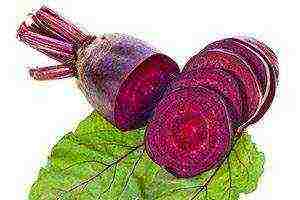
Beetroot is one of the most popular root vegetables on the Russian table. This is herring under a fur coat, and borscht, and beets with mayonnaise and garlic, all kinds of pickles and marinades. This vegetable has been grown in our country for many years.
When choosing a variety for planting, you should give preference to our, domestic varieties. And although American breeders have bred very beautiful species, with an even shape and rich color, they lag far behind in taste. Also, beets, adapted to our weather conditions, grow better and give a richer harvest. In this article, we'll take a look at the most popular sweet beet varieties.
Varieties and short classification

There are several types of beets:
1. Stern. Used to feed animals.
2. Dining room. The most popular and largest group of beet varieties. It is it that the bulk of the population eats.
3. Sugar. Beets are white and elongated, with a high (about 20%) sugar content. It is used both for food and for animal feed.
4. Sheet Chard. It is very common in Europe. It looks like spinach.
5. Wild growing.
In Russia, beets appeared in the 10th century. She was brought to us from Byzantium
According to the ripening period, table beets are subdivided:
- Early (ripen in 50-80 days);
- Mid-season (ripen in 80-100 days);
- Late (ripen in 100-135 days).
Also, the vegetable can be classified according to the shape of the root crop.
- round
- cylindrical
- flattened.
The varieties with the highest sugar content
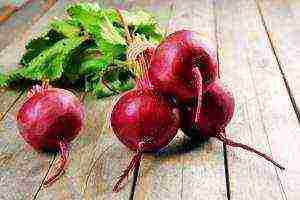
Bordeaux beets
Among table beets, several varieties with increased sweetness can be distinguished. Naturally, their sugar content is lower in them than in sugar beets, but still quite high. Let's list some:
1. "Bordeaux". This is a mid-season variety. The color of the fruit is dark red with a weight of up to 0.5 kg. The sugar content in them reaches 12-13%. This is one of the most popular varieties. He:
- tolerates hot climate well;
- high yields do not depend on the weather;
- perfectly stored.
2. "Darkie".
Mid-season variety. The fruits are dark red outside and red-purple inside. The sugar content is 7-15%. The root vegetables are tasty and juicy.
3. "Bikores".
Early ripe variety. Rounded root vegetable (weight 160-320g). The pulp is red and juicy. Sugar - 11-18%. Stores well in winter.
4. Detroit.
It is very popular among summer residents. The root crop is round and pleasant to the touch, red in color. This species is highly productive and keeps well in winter. The sugar content is 12-14%.
5. "Rocket".
The most productive cultivar with a cylindrical fruit. Tastes very sweet. Sugar content 11.7%.
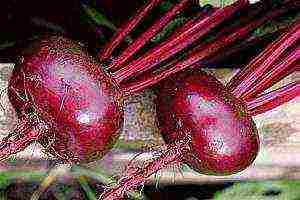
Egyptian flat
6. "Action".
An early ripe hybrid variety intended for bunch production and short-term storage. Delicious fruits with dark red flesh. Sugar - 11%.
7. Bona.
Delicious, mid-ripening variety. Sugar - 12%. The fruit is round, the flesh is dark red.
8. "Egyptian".
An early ripening variety that is very popular among gardeners. The fruits are delicious with reddish-purple flesh. Stores very well all winter. Easily tolerates dry periods.
It is interesting: it is believed that beets with a more intense pulp color contain more vitamin C.
Features of growing sweet beets
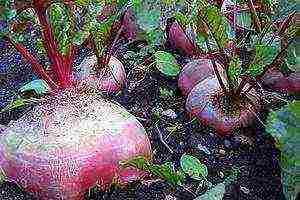
Beets are an unpretentious culture, but why does one housewife have the same vegetable sweet and juicy, while the other has a fresh and woody one?
There are two main reasons:
1. Degeneration of the variety itself. There is nothing the gardener can do here. The culture needs to be completely renewed.
2. Improperly created conditions for planting and growing beets.
In order for root crops to be sweet and tasty when grown at home, the following recommendations must be followed.
The culture does not like dry and hard soils, when grown in such conditions, it becomes bitter. It is recommended to sprinkle clay soils with sand and dig up.
Note: the sugar content of beets can be increased by ordinary table salt. It is enough to dilute one tablespoon in a bucket of water and spill the garden with this solution.
It's also important to remember that pouring mullein on the ground and dusting it with ashes improves the taste. You also need to pay attention to watering: in arid conditions, the taste also becomes bitter.
It is believed that varieties intended for winter storage are less sweet. A thrifty summer resident in the beds can always be found, in addition to varieties for storage, and crops planted for summer use. Knowing natural ways to eliminate the bitterness of beetroot crops, you can enjoy the taste until the next harvest.
We suggest you watch a video about the Egyptian beet variety:
Rate the article
(
estimates, average:
out of 5)
.
Sugar beet is a root vegetable from the amaranth family. It is probably difficult to find a person who would not like sweet beets, well, or not appreciate them for their beneficial properties. Indeed, it is true that it has so many useful properties that it can already be prescribed as a drug. What types of beets are there? This issue is worth discussing.

Beetroot is a very healthy vegetable
History of appearance
As a species, sugar beet has been known to mankind since antiquity; archaeologists often find fossilized seeds of this culture during excavations. This fruit was first recognized in the Mediterranean and Asia. Now the roots of the plant, the fruit itself, are used for food. But in ancient times, leaves were eaten. But the root, in those days, was used for medicinal purposes. Later, traders brought beets to Europe, where they were also able to appreciate all the useful properties of this vegetable.
Beet varieties for feed were bred in Germany in the 16th century, but table and sugar varieties were produced later.
Interesting fact. In some ancient countries, such as Persia, ancient Rome and Turkey, this root vegetable was a symbol of strife. True, this did not prevent them from eating it.

Fodder beets are one of the first types
Today, in most countries, varieties of sugar beets are grown. Selectors in Europe were involved in breeding such species. The fact that there is a large amount of sucrose in beets initially became known to the scientist Marggraf. To speed up the process of breeding new sugar beets, Napoleon also put in a lot of effort. He wanted to destroy the sugar trade in England. For this, he even announced a prize to those who find the technology by which they will receive sugar from sweet root crops.
Still, the extraction of sugar from sugar beets has long been an expensive process. For a long time, sugar was even more expensive than honey, and in Russia it was eaten as an expensive delicacy.
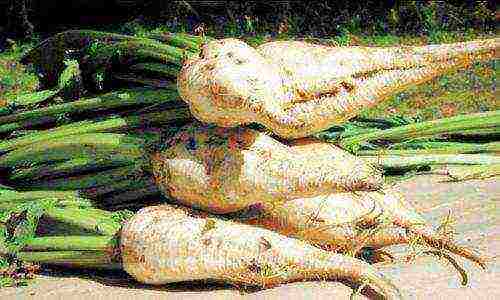
Sugar beets are a source of high quality sugar
Now only the best varieties of beets are used for sugar production.
Useful properties of sugar beet
The beneficial properties of this plant are countless. It is used for:
- blood diseases;
- hearts;
- liver.
Beets are rich in vitamins C, A and group B. It contains a lot of zinc, magnesium, manganese, zinc, iron, copper!
Sugar beet:
- improves memory;
- enriches the blood with iron;
- reduces the growth of cancer cells;
- fights cholesterol.
And this is not the whole list of medicinal qualities. Cosmetologists recommend drinking the juice for healthy skin. Also, some girls with the help of a root crop maintain a slender figure.
Types of sugar beets
There is a wild sugar beet, and a cultivated one. Wild sugar has a thin root and is not eaten. We are more accustomed to beets (aka beetroot), which gardeners grow on their plots. It has a thick, round or cylindrical root.
Sugar beet is a two-year-old root vegetable.
It has rich green leaves. The fruit is elongated, cylindrical in shape and light yellow (close to white) in color. Due to the amount of sucrose, this root vegetable is used to make sugar. Thanks to this property, it got its name. Sugar beets are often used to feed animals.
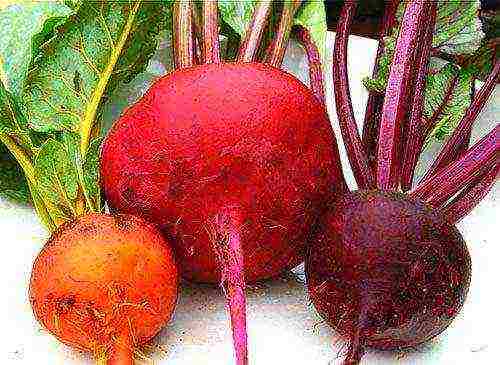
Types of beets - roots of different colors
But sugar beet varieties are used for more than just sugar production. Alcohol is made from it, and even yeast, as well as other products. It is used to make jam and moonshine. It is useful for diseases of the blood, heart and gastrointestinal tract.
Growing sweet beets
Sugar beets love sunlight and moisture. Therefore, if you are going to grow sugar beets, it is worth remembering about regular watering and weed control. Like any other plant, white beets require care and, if necessary, treatment for diseases. The earth should be loose and rich in useful trace elements. It is worth thinking about this in advance, and it will not be superfluous to fertilize the ground before planting beet seeds.You need to know that if you plan to closely engage in the cultivation of this crop, then you should not allocate the whole garden for it, the seeds are well accepted and give one hundred percent yield. It is worth allocating 20% of the plot for it, this is enough for animal feed. This is done so that the earth has time to recover. The next time on this site it will be possible to plant a crop in 3-4 years. If you want to get a crop, then do not plant in the area where legumes, cereals, flax used to grow ... They take useful microelements from the ground and greatly deplete the soil.
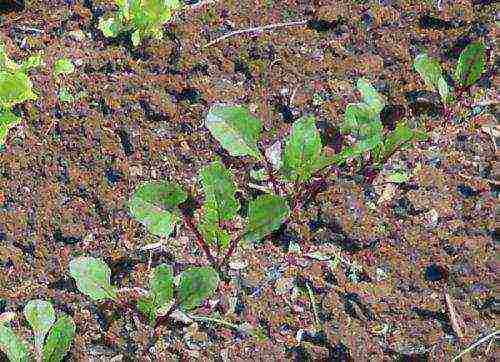
Growing beets can be carried out by sowing and through seedlings
The soil for planting this culture is prepared in the fall. The land should be fertilized and plowed before sowing seeds.
Since beets are a cold-resistant plant, it is possible to plant seeds in the prepared soil when the earth warms up to +6 degrees. For this, it is better to choose a sunny day. Seeds are sown in rows, the distance between the rows is 40-70 cm (as you prefer). If the weather is favorable to you, then the seed will sprout in a week and a half. Loosen the land, water and fertilize, remove weeds, and make sure that there are no pests.
Beets give good yields
When left in open ground, the crop will ripen in mid or late September.
Growing sugar beet in Siberia in open field conditions
Siberia has a rather harsh climate. Here, even in summer, there can be very cold nights, late frosts are not excluded. But even in such a harsh climate, sugar beets can be grown here. For this, the best way is to use seedlings. Plant the seeds in pots at home and wait for the seed to sprout. It is best to use selected cultivated seeds.
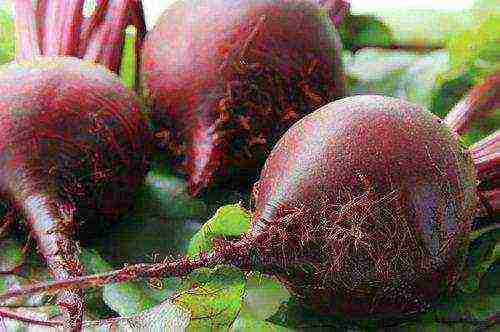
The Incomparable variety gives excellent yields in Siberia
To get a good harvest in the open ground of Siberia, it is necessary to choose cold-resistant species. Such best varieties of beets as Pablo, Cylindra, Incomparable will suit you. If you take good care of your seedlings, you can be sure that you will get the best harvest.
Beet varieties
Sugar sugar is usually divided into 3 groups:
- fruitful group - mainly beetroot;
- sugary group - one-germ;
- yielding-sugar group - the most demanded varieties of beets for consumption.
The productive group includes varieties for open ground, which bring a large harvest. The fruits themselves contain a small to medium amount of sugar.

Beet seeds of different types are very similar - get them in specialized stores
The sugar group is distinguished by varieties rich in a large amount of sugar. True, this group is not very productive and is practically not grown at home.
The sugar-yielding group includes varieties with a high sugar content, and are distinguished by high yields.
What are the best varieties of the sugar group?
Biysk single-seeded
Refers to the fruitful and sugary species. It has a high sugar content (up to 25%) and good tolerance to low temperatures.
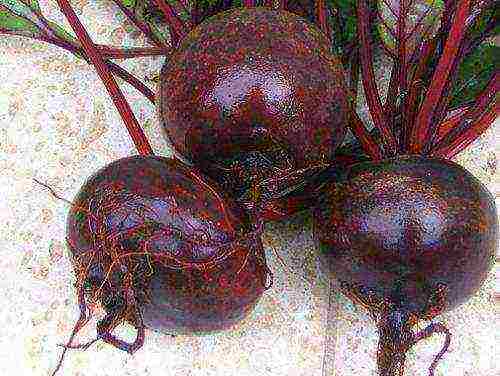
Beet variety Biyskaya
Detroit
Good early ripening variety. It tolerates cold easily. It has a round, small size. The fruit is red, juicy and sweet. This variety is fruitful and easy to store for a long time.
Crystal
This variety grows to a very large size. One fruit can be up to one and a half kilograms of net weight. It has a slightly oval shape. Differs in good resistance to various diseases of the species. Gives a good harvest.
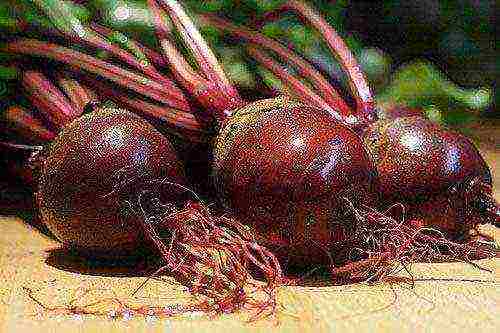
Beet variety Crystal
Bohemia
This fruit is medium in time to ripening. The surface is maroon, just like the pulp, it has no rings. A juicy sweet variety, easily suitable for a garden at a summer cottage. Unpretentious. By weight it reaches up to half a kilogram apiece.
Red ball
Dark red round, very sweet flesh. The seed of this plant emerges early, as this beet is cold-resistant. Refers to the crop group.The mass of one root crop is from 200 to 500 grams.
Mulatto
It is a mid-season root crop that has a rounded shape. Over time, the pulp acquires a maroon color. It is very tasty, sugary, but not sugary, has no rings. It is valued for being well stored in winter.
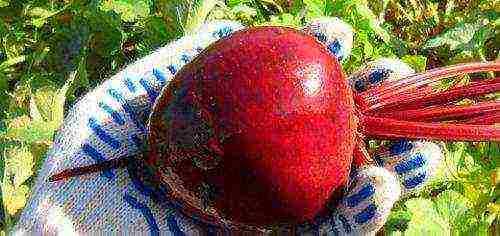
Beet variety Mulatto
Boltardi
This variety was bred by Dutch breeders. The root crop has an oval shape, ripens quickly and can be stored for a long time. It produces a good harvest and has excellent taste. Suitable for growing in gardens.
Pablo
Has a rounded shape. The pulp is red, very juicy. Gives an excellent harvest. This is a hybrid variety, recently bred. Stores well in winter. Ripens early.
Libero
The fruit is round. It grows not large, 200 g per root vegetable, unlike its other congeners, which reach 500 g. The pulp is dark red, juicy and tasty. This plant ripens early, in 80 days. This variety gives a good harvest and is resistant to various diseases of the species.
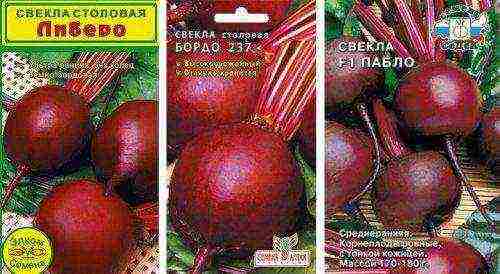
Popular varieties of beetroot
One-sprout
One-sprout is an early variety of the sugar subgroup. With proper care, the seed sprouts quickly and will take no more than 80 days to fully mature. It has a rounded burgundy color. But thinning of seedlings, single-sprout beets does not require.
Egyptian flat
It has a round, flattened shape. The ripening period reaches up to 120 days. It tolerates heat well. Suitable for southern regions. The fruits retain their freshness throughout the winter. Has a reddish-pink flesh. In terms of taste, this fruit is delicate and tasty.
Mona
The most capricious root vegetable. Requires abundant watering, thinning of the beds, and periodic groundbait. It has a dark red color, cylindrical shape, pronounced sweetish-cloying aftertaste. Ripens medium-early.
Red bullet (similar in characteristics to Mona)
The most popular type of red beet. It has a medium early ripening, 100-120 days. Outwardly, these two varieties are also similar, they both have a cylindrical shape and similar taste. By weight no more than 350 g. This beet retains useful properties even in winter.
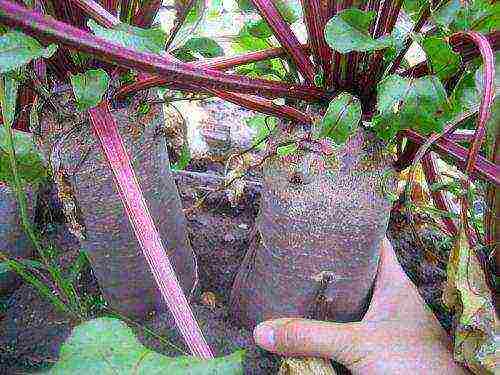
Beet variety Cylinder
Cylinder
As the name suggests, it has a cylindrical shape with smooth curves. This is the most popular variety; gardeners like it, as it is weakly susceptible to diseases. Due to its sweet taste, this fruit is easily eaten, added to borscht and salads, and not only the root vegetable is used in salads, but also the leaves of this beet. Housewives use it in preserves.
The use of sugar beet
Sugar beet is a two-year-old root vegetable. Since this plant contains a lot of sucrose, it is used to make sugar. This sugar is more valuable than its sugarcane counterpart.
In addition to the fact that beets are used to make borscht, salads and jams, cookies are made from them.
Doctors recommend eating the root vegetable for people suffering from anemia. Long-term intake of the pulp improves the body's immune resistance. Even a sore throat can be cured with the help of juice. To do this, take a glass of squeezed juice and add a tablespoon of honey to it. Mix the resulting solution thoroughly and gargle with it. This procedure should be performed up to six times a day. The juice is recommended even for bronchitis, pneumonia, and kidney disease. But, nevertheless, beets, along with positive properties, have negative sides. It is not recommended to eat it for people who are sick with urolithiasis.
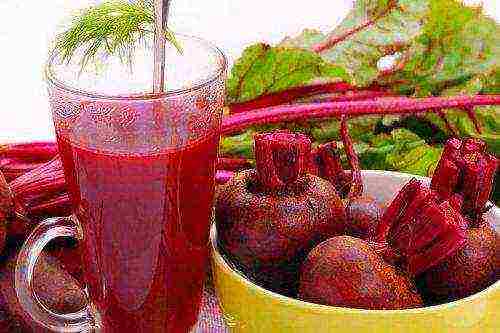
Beets can be eaten in a wide variety of forms
Farmers also use the culture in agriculture. Along with fodder, they give it to livestock and birds. Birds, thanks to such nutritious complementary foods, quickly gain weight.
Beets are practically waste-free. After processing, molasses remains, and alcohol, glycerin, citric acid, and other products are already made from it.
Subscribe Be aware of new products on our site
The concept of "the best varieties of beets" is very arbitrary. It is important for someone that there are no white rings; someone - to be kept for a long time; the third loves cylindrical beets, the fourth wants to grow a sweet root vegetable. Fortunately, hybrids and varieties of canteen beets delight in variety and are able to satisfy the tastes of almost any gardener.
Therefore, we propose to divide the varieties of table beets according to the most important classifications, so that it is easier for you to choose the appropriate variety (by size, shape, ripening time, etc.)
Beet varieties in terms of ripening are:
— early maturing... The fruits of early ripening varieties ripen in about two months: planted in May, and at the end of July you can already harvest the first crop! But the only problem is that such a root crop is stored quite badly, so it is not worth much to plant early varieties of beets. The best varieties of canteen beets from the early - Detroit, Egyptian Flat, Bona, Red Ball, Mulatto, Bovine Blood, Cold Resistant 19.
- mid-season... The best option for gardeners living in the Middle Lane is the cultivation of mid-ripening beets (ripening periods - 80-100 days). Such beets are stored quite well, and have excellent yields, and their taste is more remarkable than that of the early beets. The best varieties of mid-season beets: Bordeaux 237, One-sprout, Incomparable, Cylinder, Winter, Pablo
— late ripening. Late-ripening varieties (ripening period - 100-135 days) are best suited for long-term storage. But their main drawback is that in the Middle Lane they do not have time to mature normally, therefore, late varieties of beets are planted only in more southern regions.
Table beets, depending on the shape, are:
- flattened (Egyptian flat, Incomparable, Nosovskaya flat, Bona)
- cylindrical (varieties of the Cylinder, Mona, Ataman, Torpedo)
- rounded (varieties Pablo, Mulatka, Detroit, Bordeaux 237, Red ball, Boltardi, Darkie, Kestrel)
What are the best beetroot varieties to store?
Best stored beets of Bordeaux 237, Podzimnyaya, Incomparable, hybrid Pablo F1, Nosovskaya flat.
Which beet varieties are suitable for winter sowing?
It is best to use beets of the Cold-resistant 19 and Podzimnyaya varieties for podzimnyaya sowing.
What are the sweetest varieties of beets?
Cylinder (most varieties of cylindrical beets are characterized by a high content of sugars), Mulatto, Red Ball, Detroit, Incomparable, Darkie, Kestrel,
The best beetroot varieties without light rings:
Pablo F1, Cylinder, Detroit, Boltardi, Kestrel
Characteristics of beet varieties with photos and descriptions
And now we bring to your attention a description of the varieties of red beets - the most popular, most productive and in demand today.
Beet Pablo F1
The most popular beetroot today is a hybrid of the Dutch selection Pablo F1. Its secret is in the optimal combination of a small shape, almost complete absence of white rings, sweet taste with unpretentious cultivation. It belongs to the medium early, it is resistant to adverse weather conditions (cold, moisture deficit) and, which is very important, to the quality of the soil. Therefore, it can be grown in Ukraine, and in Belarus, and in Moldova, and in the northern regions of Russia. Thus, Pablo F1 is one of the best beet varieties for the Urals.
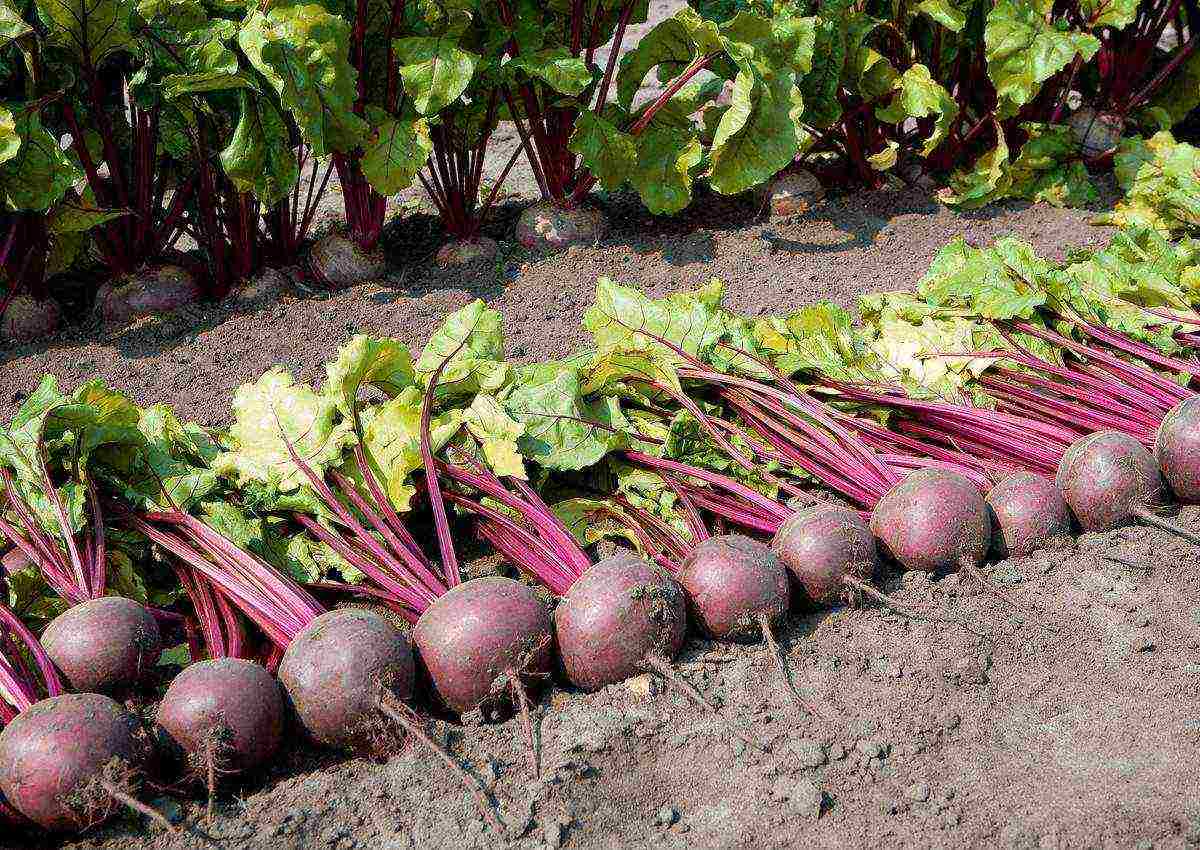

The root crop is stored without losing its shape and taste for several months, it is not prone to cracking, shooting and flowering, it is resistant to many dangerous diseases (scab, cercospora, corneed). Pablo F1 beets have a straight, medium-sized rosette, round-shaped fruits, weighing 100-150 grams (sometimes up to 200-250 grams), 10-15 cm in diameter, average yield - up to 7 kg per "square". The color of the pulp is burgundy-purple, the skin of the root crops is burgundy, smooth, rather thin. The growing season is 100-110 days.
Beet Cylinder
Another very popular, time-testedbeet variety - Cylinder... Gardeners fell in love with it for a rather long shelf life (more than 4 months), sweet juicy pulp without the notorious rings, very tasty, as well as resistance to major diseases of root crops.
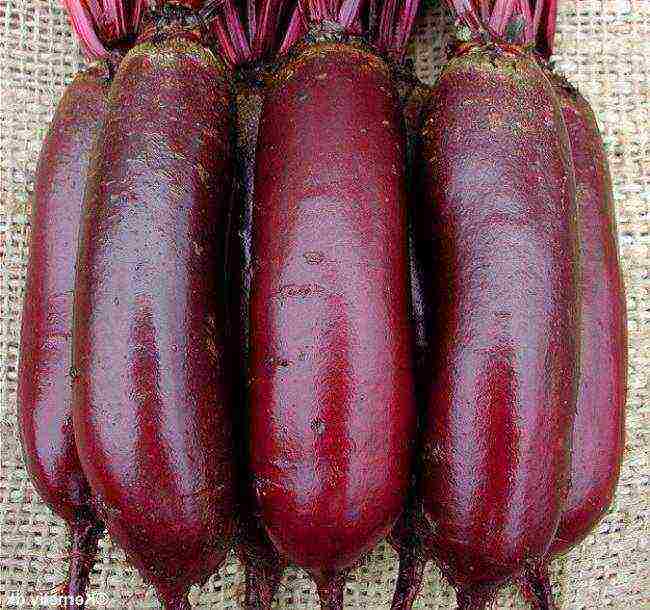
The Cylinder beet variety belongs to the middle late (ripening period - from 120 to 130 days). The shape of the fruit is elongated, cylindrical, diameter - 5-8 cm, length - 10-15 cm. Fruits are medium-sized, with dark skin, weighing 150-250 grams (sometimes more). Cylinder beets are often grown for sales because the roots grow neat, even, and even. Productivity - more than 7 kg per "square", and the "cylinders" are pulled out of the ground very easily.
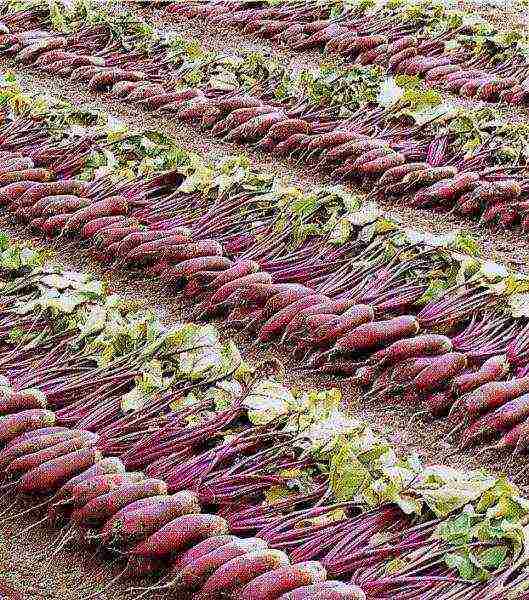

Also in favor of the Cylinder beet is the fact that improved hybrids were developed on its basis - Daughter F1 cylinders and Granddaughter F1.
Beet mulatto
This is a mid-season beet variety (110-120 days), which appeared on store shelves not so long ago, but is already loved by gardeners. The beet variety Mulatto is not very rich in color of the pulp (not burgundy or ruby, namely dark red), but this in no way affects the richness of the taste - it is juicy, sweet, very tasty. After heat treatment, it does not change color, which is important for borscht lovers. Root crops are round, not too large (150-300 grams), smooth. 4-5 kg of mulatto beets are harvested from one "square" of the garden. This variety is suitable for winter storage, resistant to temperature fluctuations, unpretentious to soil, immune to flower beds. Among the disadvantages of mulatto beets is increased demand for lighting; in the shade, the root crop will grow savory and small.
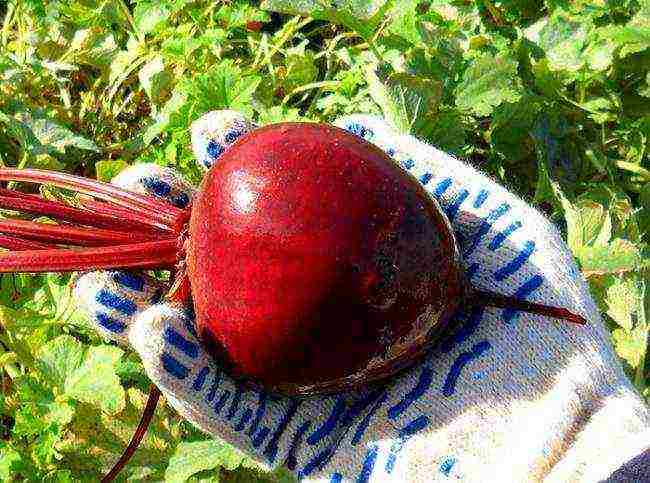
Egyptian flat beet
Bred almost 80 years ago, this beet variety is still popular today, which says a lot. Of course, Egyptian flat beets are not as sweet and tasty as some new varieties (in other words, they taste as usual), they will not last until summer (although 70-80% of root crops will survive the winter), and even to Cercospora, the main enemy of beets, this variety weakly stable. But the Egyptian flat beet also has advantages, thanks to which it still remains among the leaders in the preferences of summer residents: unpretentiousness to soils, the ability to tolerate long periods of drought without damage, and resistance to flowering.
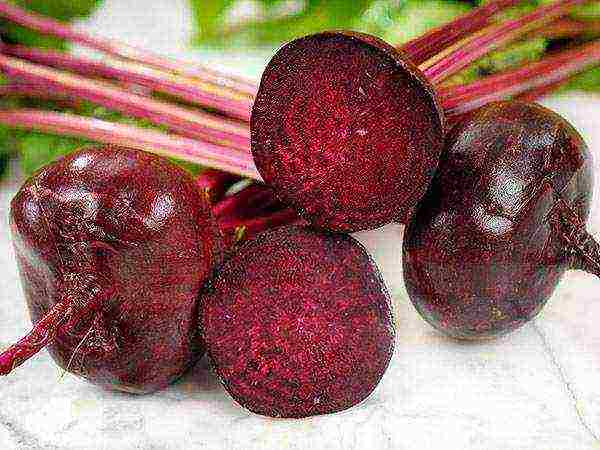
The characteristics of the Egyptian flat beet variety are as follows: the ripening period is 90-100 days (medium early), the root crop grows flattened, small, neat, the average weight is 200-350 grams, but there are specimens up to 500 grams, 4- 8 kg of root crops; the color of the pulp is burgundy-purple, without pronounced rings.
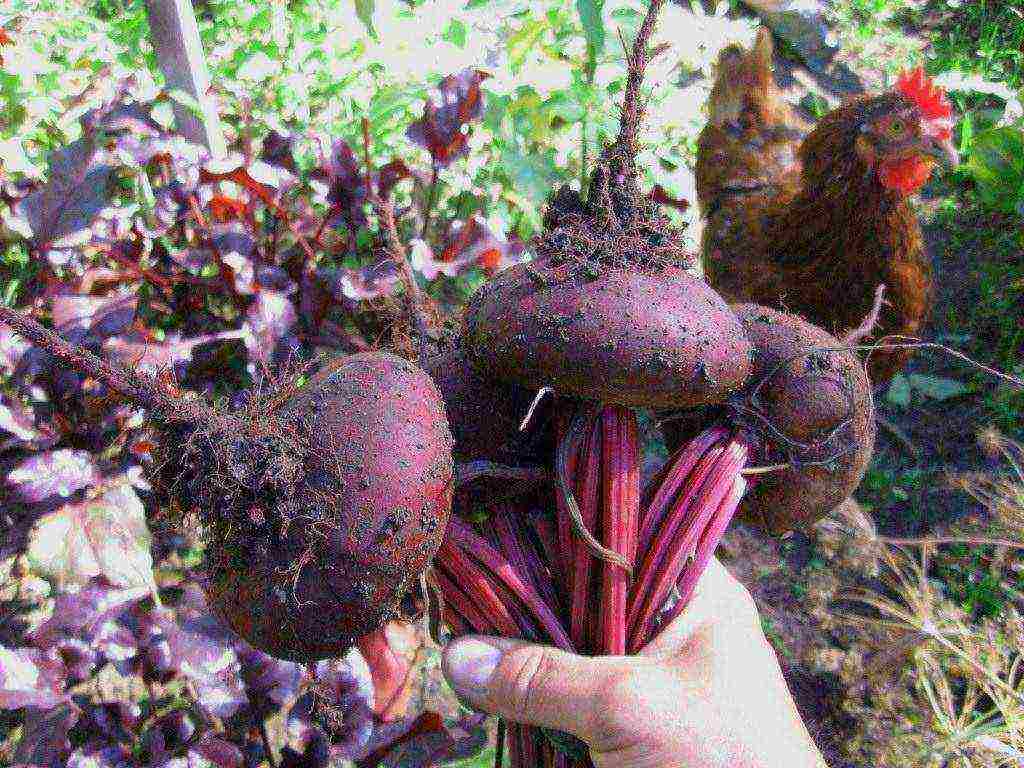
Bordeaux beet 237
Beet variety Bordeaux 237 - another time-tested, reliable, and for many summer residents - the best variety of red beets. Rounded, neat root vegetables with rich burgundy juicy sweet pulp are not too large, so they are convenient to process, bake, Bordov 237 is well suited for salads. The variety is famous for its stable yield, good germination, heat and drought resistance and the ability to store well - until spring, or even until the new season, will lie in the cellar without frowning or shrinking.

Bordeaux 237 beets are medium early (ripening period - 70-110 days), root crops grow weighing from 200 to 500 grams, with a diameter of 10-15 cm, the shape is round or slightly flattened. The variety is considered resistant to diseases, but in some years it is affected by peronosporosis and cercosporosis. From the "square" of the garden, you can collect from 4 to 8 kg of beets.
Detroit beet
Perhaps the most popular of the early-growing beet varieties today. Still - during the season Detroit can be sown twice, since the ripening period of the root crop is only 650-100 days. Taste qualities beetroot detroit gorgeous - it is juicy, dark red, has a pleasant sweet taste. Root crops grow small (from 100 to 200 grams), but aligned, round, smooth, with a very small axial root - in general, very marketable.Among other advantages of Detroit beets - resistance to flowering, to cold.
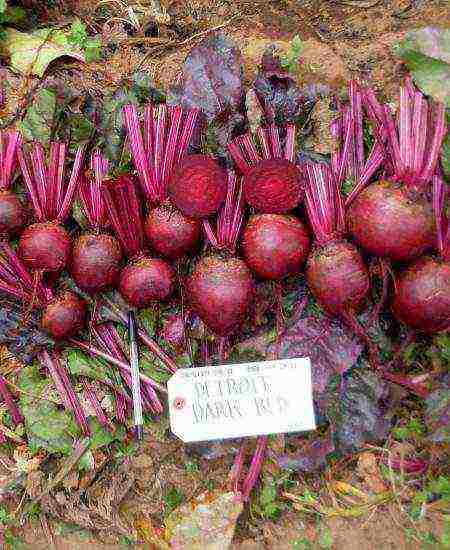
As for early beets, Detroit is stored well, but for laying for a long winter storage, it is still better to choose another variety, mid- or late-ripening. Another unpleasant bonus of this early maturing beet is its weak resistance to diseases, increased demand for watering and light.
Beetroot red ball
It is an early variety with a ripening period of 65-100 days, which is famous for its very juicy, dark red, almost purple sweet flesh, practically without rings on the cut. It is recommended for use in dietary and baby food, and, of course, in cooking (it cooks quickly, but does not have an unpleasant "beetroot" aftertaste). Beet variety Red ball is resistant to cold weather, flowering, stemming, drought and disease resistance - medium. Root crops grow round, weighing 200-500 grams. Productivity of beets Red ball is high, up to 6 kg of root crops are harvested from the "square" of the garden. Stored without problems until spring.
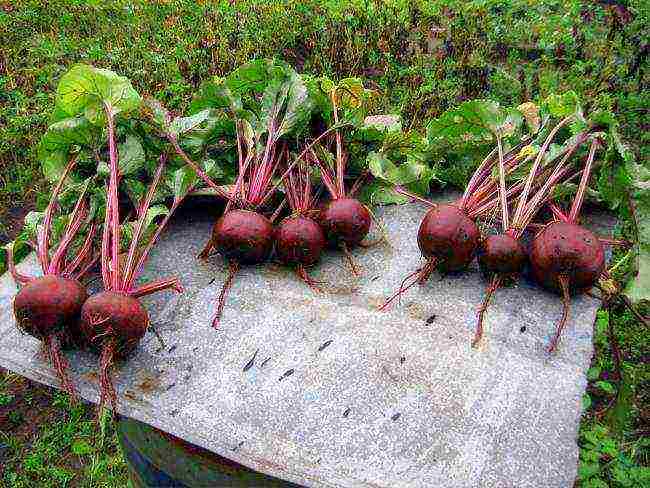
Beet Mona
The mid-late representative of the beet is cylindrical, so in the middle lane it may not have time to ripen. Beet variety Mona good because it is one-sprout (not 3-5 sprouts grow from one seed, but only one), so thinning is not required. As a result, root crops form quickly, grow even and delight with a stable yield. Despite its elongated shape, this beet is easily pulled out of the ground, as it will plunge into the soil only a third of its length. The average weight of Mona beets is 200-350 grams, length is 10-20 cm, diameter is about 5 cm, pulp is tender, juicy, dark red, rings are almost invisible. The yield is high - 6-7 kg of root crops from the "square" of the garden.

Beet Incomparable
This beet got its name for its excellent taste - its pulp is juicy, very sweet, dark red with almost black rings. Beet variety Incomparable refers to early maturing (70-96 days). Root crops grow round or slightly flattened, weighing 150-400 grams, are stored, despite early maturity, well - until spring. Of the features - incomparable beets do not like heavy soils, are weakly resistant to cercosporosis, resistant to flowering, stemming and cold weather.
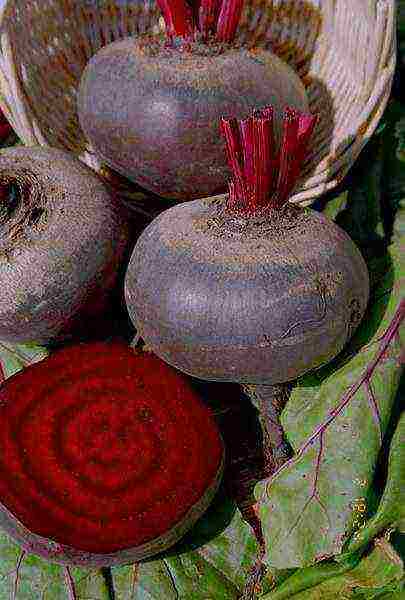
Boltardi beet
An early maturing variety (70-100 days), which, due to its cold resistance, can be sown very early in the open field. Roots beetroot boltardi grow small (150-350 grams), but very even, smooth, neat rounded shape. The pulp deserves special attention: it is completely ringless, burgundy-purple, very sugary and juicy. Suitable for bookmarking for long-term storage. Boltardi beets are considered resistant to diseases and flowering, but demanding on watering and feeding. From the "square" of the garden, you can collect 3-8 kg of root crops.
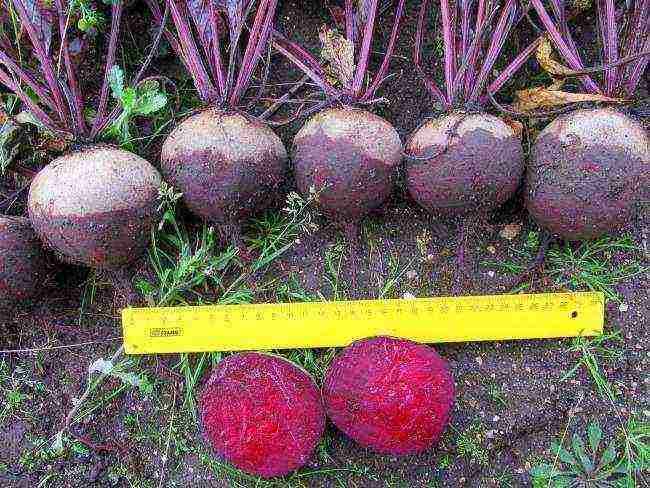
Beetroot bovine blood
This beet variety is for lovers of large root crops: the weight of one specimen can exceed 600 grams. Beetroot bovine blood - a medium late variety (110-120), distinguished by resistance to cold weather, flowering and excellent keeping quality. The beet pulp is dark red, with slightly pronounced rings, but without hard veins; after cooking, the color does not change. In the characteristics of the beet variety, it is indicated that the weight of root crops is 150-240 grams, but in fact, gardeners note that the real weight of Bovine blood is 2 or even three times higher.
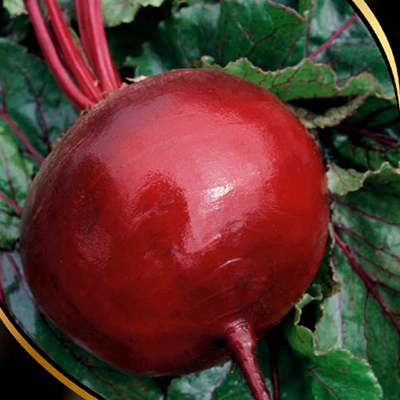
Bona beet
This is a relatively new variety of beets with medium ripening periods (105-120 days), which summer residents fell in love with for the juicy, delicate, sweet taste of the pulp, small uniform rounded root crops weighing 200-300 grams and good keeping quality. Beet variety Bona pleasant in that it has no rings on the cut and is resistant to most diseases. You can collect 5-7 kg of root crops from the "square" of the garden.
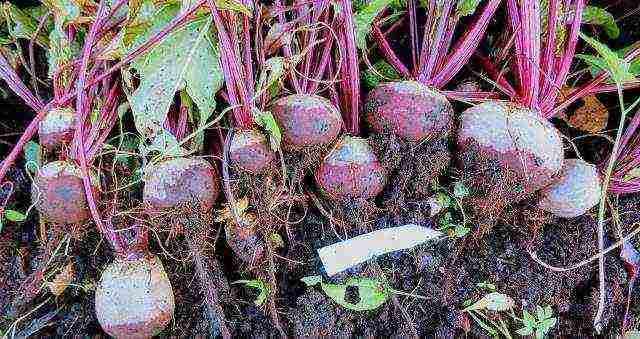
Beetroot
Popularity beet variety Smuglyanka due to its sweet, rich taste, dense pulp of bright pink-purple color and very good keeping quality.Smuglyanka beet belongs to mid-season varieties (95-110 days), root crops grow up to 200-400 grams in weight. Among other advantages of the variety are the stability of yields, cold resistance, resistance to flowering.
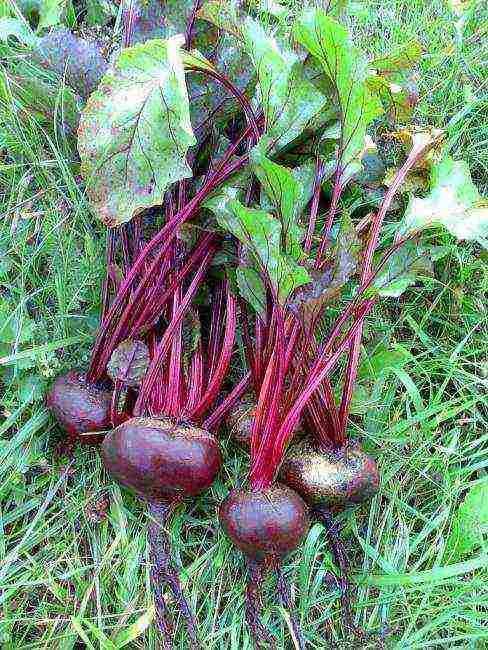
Podzimnyaya beet A 474
From the name it is obvious that this is one of the best varieties of beets for winter sowing. Overall beets Podzimnyaya A 474 is a mid-season variety (95-105 days), and is suitable not only for winter sowing, but also for early spring. Differs in dark red flat-rounded roots, growing up to 200-300 grams. Podzimnyaya beet pulp A 474 is sweet, juicy, with a good taste and dark red color. Equally important features of the variety are cold resistance and suitability for long-term storage.
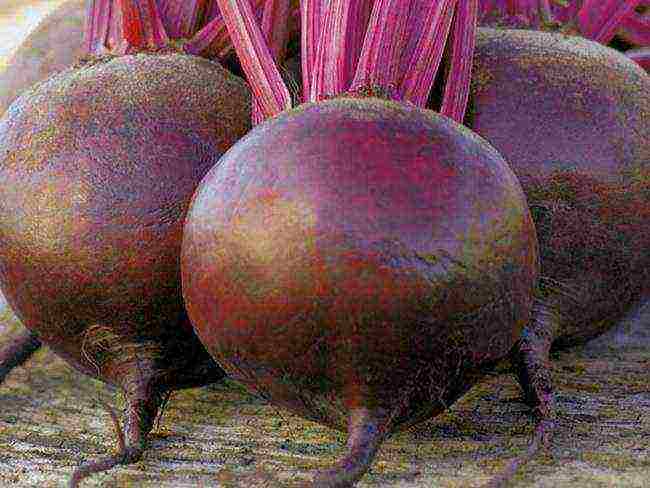
Beet Kestrel F1
One of the main canteen beetroot hybrids for Europe and the USA. Moreover: abroad Kestrel F1 is one of the quality standards and high yield. It is used in baby food and juices, as the rich red color does not "fade" after heat treatment. Same beet hybrid Kestrel F1 possesses excellent commercial qualities - uniformity of root crops, good transportability, high sugar content, keeping quality.
Beet Kestrel F1 belongs to mid-season hybrids (90-100 days) with a small root process, a smooth surface, a small leaf rosette. The average fruit weight is from 300 to 400 grams.

Of course, these are not all the best varieties of table beet. From the early one can be distinguished Odnorostkovaya, Libero, Vinaigrette Marmalade, Gribovskaya flat, Crimson, Borshchevaya, Kubanskaya; from mid-season - Bohemia, Negritanka, Tenderness, Opolskaya, Bon-Bon, Larka; from the later ones - Ataman, Torpedo, Renova. This is not to mention hybrids, of which a lot has appeared recently!


